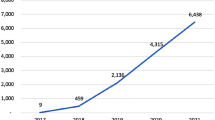Abstract
In Germany, more than 400,000 arthroscopic procedures are performed each year. The DART registry is designed to study the outcome of arthroscopic procedures of the shoulder, hip, knee and ankle joint under everyday clinical circumstances using patient-reported outcome measures (PROMs). DART aims at identifying patient-specific factors correlated with therapy-associated complications and treatment failure and will help study the influence of concurrent joint diseases and procedures. To achieve these tasks, a Web-based remote data entry system will be applied and adapted to the needs of DART. DART will consist of a physician’s and a patient’s form to enter data on the specific disease, surgical procedure, joint-specific outcome, disability and quality of life measured by validated scores up to 5 years following surgery. The pool of data will be subjected to further clinical investigations and subgroup analysis. Individual results will be made accessible to the surgeon and the patient. Moreover, public reports will be generated to provide healthcare authorities and insurance companies with information on the effectiveness of arthroscopic surgery. The aim of this article is to present the methodology of the registry.
Level of evidence V.
Similar content being viewed by others
References
Ahldén M, Samuelsson K, Sernert N et al (2012) The Swedish National Anterior Cruciate Ligament Register: a report on baseline variables and outcomes of surgery for almost 18,000 patients. Am J Sports Med 40(10):2230–2235
Benson K, Hartz AJ (2000) A comparison of observational studies and randomized controlled trials. N Engl J Med 342(25):1878–1886
Engebretsen L, Forssblad M, Lind M (2015) Why registries analysing cruciate ligament surgery are important. Br J Sports Med 49(10):636–638
Gabr A, O’Leary S, Spalding T et al (2015) The UK National Ligament Registry Report. Knee 22(4):351–353
Herrlin SV, Wange PO, Lapidus G et al (2013) Is arthroscopic surgery beneficial in treating non-traumatic, degenerative medial meniscal tears? A five year follow-up. Knee Surg Sports Traumatol Arthrosc 21(2):358–364
Katz JN, Brophy RH, Chaisson CE et al (2013) Surgery versus physical therapy for a meniscal tear and osteoarthritis. N Engl J Med 368(18):1675–1684
Kirkley A, Birmingham TB, Litchfield RB et al (2008) A randomized trial of arthroscopic surgery for osteoarthritis of the knee. N Engl J Med 359(11):1097–1107
Kukkonen J, Joukainen A, Lehtinen J et al (2015) Treatment of nontraumatic rotator cuff tears: a randomized controlled trial with two years of clinical and imaging follow-up. J Bone Joint Surg 97(21):1729–1737
Kvist J, Kartus J, Karlsson J et al (2014) Results from the Swedish national anterior cruciate ligament register. Arthroscopy 30(7):803–810
Maletis GB, Granan LP, Inacio MC et al (2011) Comparison of community-based ACL reconstruction registries in the U.S. and Norway. J Bone Joint Surg Am 93(Suppl 3):31–36
Maurer J, Grotejohann B, Jenkner C et al (2016) A registry for evaluation of efficiency and safety of surgical treatment of cartilage defects: the German Cartilage Registry (KnorpelRegister DGOU). JMIR Res Protoc 5(2):e122
Moseley JB, O’Malley K, Petersen NJ et al (2002) A controlled trial of arthroscopic surgery for osteoarthritis of the knee. N Engl J Med 347(2):81–88
Niemeyer P, Schweigler K, Grotejohann B et al (2015) The German Cartilage Registry (KnorpelRegister DGOU) for evaluation of surgical treatment for cartilage defects: experience after six months including first demographic data. Z Orthop Unfall 153(1):67–74
Sansone M, Ahldén M, Jonasson P et al (2014) A Swedish hip arthroscopy registry: demographics and development. Knee Surg Sports Traumatol Arthrosc 22(4):774–780
Sihvonen R, Paavola M, Malmivaara A et al (2013) Arthroscopic partial meniscectomy versus sham surgery for a degenerative meniscal tear. Finnish Degenerative Meniscal Lesion Study (FIDELITY) Group. N Engl J Med 369(26):2515–2524
Thorlund JB, Hare KB, Lohmander LS (2014) Large increase in arthroscopic meniscus surgery in the middle-aged and older population in Denmark from 2000 to 2011. Acta Orthop 85(3):287–292
Thorlund JB, Juhl CB, Roos EM, Lohmander LS (2015) Arthroscopic surgery for degenerative knee: systematic review and meta-analysis of benefits and harms. Br J Sports Med 49(19):1229–1235
Yim JH, Seon JK, Song EK et al (2013) A comparative study of meniscectomy and nonoperative treatment for degenerative horizontal tears of the medial meniscus. Am J Sports Med 41(7):1565–1570
Author information
Authors and Affiliations
Contributions
All authors are equally involved in scientific and basic technical development of DART. All authors have read and approved the final manuscript.
Corresponding author
Ethics declarations
Competing interests
The author(s) declare that they have no competing interests.
Funding
The DART project receives funding from: Society for Arthroscopy and Joint Surgery (AGA), German Society for Arthroscopy (BVASK), Society for Orthopaedic Traumatic Sports Medicine (GOTS), German Society for Orthopaedics and Trauma (DGOU), Arthrex, Smith & Nephew.
Ethical approval
Depending on individual state law, investigators consult the responsible ethics committee before commencement of the study at their site. If requested, the investigators are supported by the CTU in preparation of the essential documents for the submission. After consulting the ethics committee and receiving a personal user account, investigators are allowed to take part in the registry.
Rights and permissions
About this article
Cite this article
Mueller-Rath, R., Miltner, O., Hochrein, A. et al. The German Arthroscopy Registry (DART). Knee Surg Sports Traumatol Arthrosc 25, 3657–3660 (2017). https://doi.org/10.1007/s00167-017-4708-2
Received:
Accepted:
Published:
Issue Date:
DOI: https://doi.org/10.1007/s00167-017-4708-2




